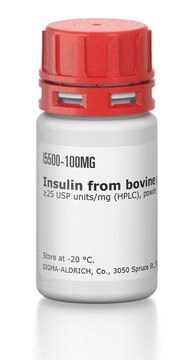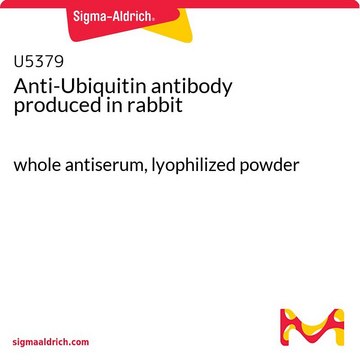U5382
Ubiquitin human
≥95% (SDS-PAGE), recombinant, expressed in E. coli (N-terminal FLAG® tagged), lyophilized powder
About This Item
Produits recommandés
Source biologique
human
Niveau de qualité
Produit recombinant
expressed in E. coli (N-terminal FLAG® tagged)
Essai
≥95% (SDS-PAGE)
Forme
lyophilized powder
Poids mol.
10 kDa
Technique(s)
mass spectrometry (MS): suitable
Solubilité
0.05 M Tris pH 7.5: ≥10 mg/mL, clear to slightly hazy, colorless
0.05 M Tris pH 7.5: ≥10 mg/mL
Température de stockage
−20°C
Vous recherchez des produits similaires ? Visite Guide de comparaison des produits
Description générale
Ubiquitin is a highly conserved protein composed of 76 amino acids, and it is expressed universally in all eukaryotes, ranging from yeast to humans.
Application
Actions biochimiques/physiologiques
Conditionnement
Notes préparatoires
Informations légales
Code de la classe de stockage
11 - Combustible Solids
Classe de danger pour l'eau (WGK)
WGK 3
Point d'éclair (°F)
Not applicable
Point d'éclair (°C)
Not applicable
Équipement de protection individuelle
Eyeshields, Gloves, type N95 (US)
Faites votre choix parmi les versions les plus récentes :
Déjà en possession de ce produit ?
Retrouvez la documentation relative aux produits que vous avez récemment achetés dans la Bibliothèque de documents.
Les clients ont également consulté
Notre équipe de scientifiques dispose d'une expérience dans tous les secteurs de la recherche, notamment en sciences de la vie, science des matériaux, synthèse chimique, chromatographie, analyse et dans de nombreux autres domaines..
Contacter notre Service technique







